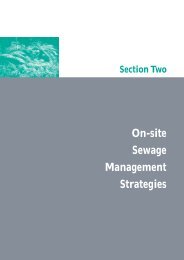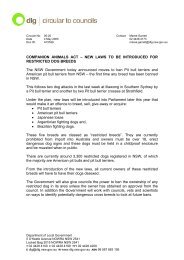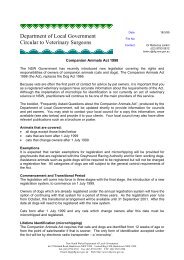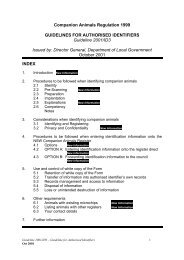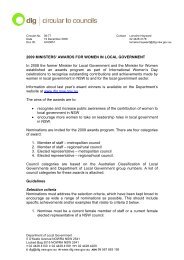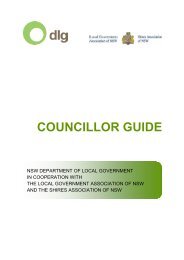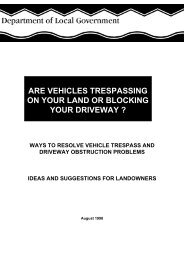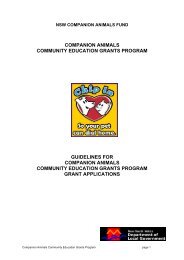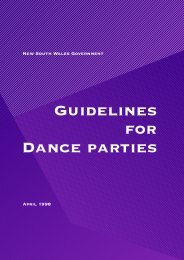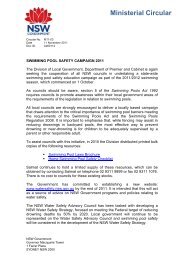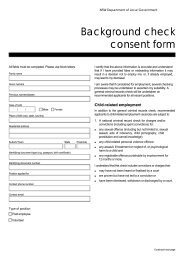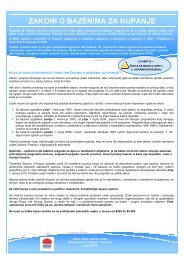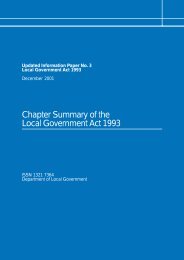Integrated Planning and Reporting Manual - Division of Local ...
Integrated Planning and Reporting Manual - Division of Local ...
Integrated Planning and Reporting Manual - Division of Local ...
Create successful ePaper yourself
Turn your PDF publications into a flip-book with our unique Google optimized e-Paper software.
2. THE COMMUNITY STRATEGIC PLAN<br />
Levels <strong>of</strong> Service<br />
One <strong>of</strong> the most important discussions councils will have with their communities during the planning<br />
process is in regard to expected levels <strong>of</strong> service. Many councils find it challenging to meet the<br />
increasing expectations <strong>of</strong> their community – particularly in rural areas where changing<br />
demographics <strong>of</strong>ten bring different views <strong>of</strong> service st<strong>and</strong>ards. Although it may be difficult to gain<br />
consensus on levels <strong>of</strong> service, it is helpful to at least hold these discussions with the community.<br />
What do people really expect in terms <strong>of</strong> rural roads or street cleaning or recreational facilities Are<br />
they willing to meet the cost <strong>of</strong> increasing expectations Can they identify priorities in service<br />
provision<br />
The Asset Management section <strong>of</strong> this <strong>Manual</strong> contains further information on determining service<br />
levels specifically in relation to assets. However, this information is also relevant to the provision <strong>of</strong><br />
services.<br />
Working with NSW Government agencies<br />
There are mutual benefits for local councils <strong>and</strong> NSW Government agencies in working together to<br />
deliver services for the community. To work effectively with State agencies, it is important to build on<br />
established relationships <strong>and</strong> utilise existing forums to identify areas in common <strong>and</strong> potential<br />
partnerships. Working on a regional basis, as part <strong>of</strong> a Regional Organisation <strong>of</strong> Councils for<br />
example, will be more efficient <strong>and</strong> effective than inviting State agencies to attend general<br />
community consultation sessions as part <strong>of</strong> the development <strong>of</strong> Council’s Community Strategic Plan.<br />
To obtain input from State agencies, in many cases it will be more effective to develop a draft<br />
Community Strategic Plan, or if working as a regional group, identify the priorities for the region,<br />
then convene a State agency forum that invites those agencies that have been identified as<br />
potential partners in the delivery <strong>of</strong> the community’s or region’s priorities <strong>and</strong> aspirations.<br />
The Department <strong>of</strong> Premier <strong>and</strong> Cabinet (DPC) facilitates regional coordination <strong>of</strong> State agencies<br />
through the Regional Managers’ Network. Councils within a particular region may find it beneficial to<br />
discuss with their DPC Regional Coordinator the best means <strong>of</strong> providing information to <strong>and</strong> seeking<br />
feedback from Regional Managers <strong>of</strong> State agencies. For example, if councils participate in a<br />
Regional Organisation <strong>of</strong> Councils (ROC) or similar regional networks, they may be able to utilise a<br />
Regional Managers’ Network meeting to provide information <strong>and</strong> obtain feedback on regional<br />
priorities <strong>and</strong> other community issues.<br />
Further information on the NSW Government’s Regional Coordination Program is available at<br />
www.dpc.nsw.gov.au .<br />
<strong>Planning</strong> & <strong>Reporting</strong> <strong>Manual</strong> Page 41 <strong>of</strong> 115



